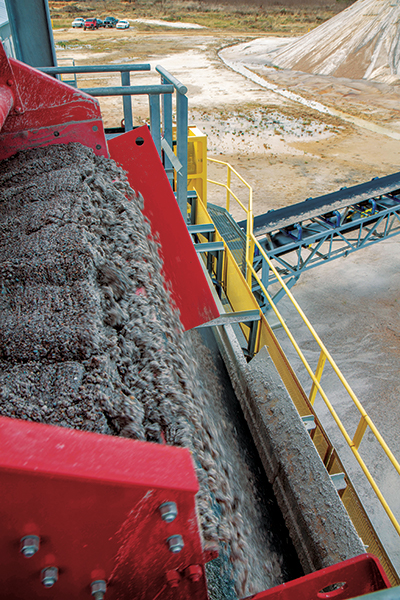Key safety areas to watch in washing operations

Motor wiring draped across a vibrating motor to the side of a dewatering screen is a dangerous condition. Check this and replace wiring as needed. Photo: McLanahan
A safe washing site is one that is as clean and as productive as possible.
Keeping equipment well-maintained will allow it to run longer and, ultimately, send employees home safely at the end of every shift. To uphold this kind of work environment, here are some safety hazards to watch for around wet processing equipment typically found on aggregate-producing sites:
1. Dewatering screens. Safer working conditions result from the use of dewatering screens, with less carryback and spillage to clean up around conveyors.
While dewatering screens typically have a very long service life, there are still some areas to watch to keep a machine running safely and effectively. For example, keep an eye on cracks in the side plate. Producers can trace the crack to its end with dye penetrant and drilling a 1/8-in. to 3/16-in. hole. This most often takes care of the problem, and the side plate will last the life of the screen.
Cracks in cross members should be referred to manufacturers immediately, as should any bolt breakage. Often, the problem with cracking in dewatering screens relates to the support structure rather than the machine’s integrity.
Additionally, lubrication is a general maintenance activity, but be cautious because some vibrator motor manufacturers require a special grease that, if not used, may void the warranty.
2. Log washers, blade mills, aggregate conditioners, coarse material washers and fine material washers. Order equipment with optional guards to prevent accidents, and add guards if there are dangerous access points.
The rear bearing assembly designs vary by manufacturer. Some are complex and feature a “submerged” bearing while others are a simple outboard pillow-block with a rubber boot seal assembly. Each claim different advantages, but they all require lubrication.
Paddles and flights need periodic inspection for wear and possible replacement. With metallic paddles or shoes, it’s important to be aware that worn ends become razor sharp and can cause serious injury if not handled properly.
It’s also important to check wear on these items and fasteners, as the latter secure the wear parts to the shaft.
Occasionally, check the shaft for runout, as a bent shaft can cause premature failure of support bearings and even the shaft. Personnel should carry out shaft straightening, but only after consulting the manufacturer’s manual.
3. Hydrocyclones. While these have no moving parts, there are two failure modes – delamination and wear – that impact performance and potentially the safety of your machine.
Liners that come loose due to wear or adhesion, causing disruption of flow inside the unit, are worth watching. This development ultimately causes poor performance with misplaced particles.
Checking the internal lining of a cyclone should be done at least seasonally. This is particularly important when dealing with siphon-assisted cyclones and separators.
The apex (spigot) is the fastest wearing component, as they are sized based on mass flow. As they wear, the underflow becomes more dilute and more fines will bypass into the stream, affecting the washout of deleterious fines.
If a product is getting dirtier, check the apex. Worn vortex finders can allow coarse fractions to short circuit to the overflow and fill the ponds or contaminate the next stage of production. The worst case is the wear can cause the pipe to detach from the plate, causing significant damage to equipment and possibly injuring an operator.
Information for this article courtesy of McLanahan Corp.









